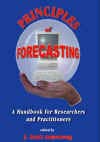In his introduction to Principles of Forecasting: A Handbook for Researchers and Practitioners, editor
Luckily, if rather inevitably, this curiosity has not been silenced. As Armstrong – who also contributed, in whole or part, seven of the book’s 29 essays and a wealth of contextualizing information – further points out, the field of forecasting is not merely a sub-specialty for economists. Rather, it has broad application to a range of areas that have an impact on people every day. Individuals rely on forecasting in their personal lives to make judgements about relationships, careers and investments; organizations rely on it in contemplating new products, factories, retail outlets and contracts with executives; and government agencies, too, of course, depend upon social, economic and environmental forecasting in formulating their decisions.
Armstrong has been studying, writing and teaching about forecasting for more than three decades now. His practical and professional involvement in the field has deep roots as well. In 1964, for example, his resume indicates that he “developed Xerox’s first computer program for short-range forecasting for inventory control of finished goods.”
Individual sections of Principles of Forecasting illustrate Armstrong’s approach to his subject. The part on “Judgmental Bootstrapping: Inferring Expert’s Rules for Forecasting,” for example, begins like this:
“In the early 1970’s, I was flying from Denver to Philadelphia. Some fit young men were on the flight. Wondering who they were, I turned to the person next to me to see if he knew. He did. His name was Ed Snider, and he owned the Philadelphia Flyers, the hockey team whose players were on this flight. Before we were out of Colorado, I realized that this was my big chance. I would convince him to use my services to select hockey players by developing judgmental bootstrapping models. Sports writers would learn about me. Other teams would then flock to my door. I would become rich and famous.”
As Armstrong explains further on:
“In judgmental bootstrapping, the reasoning of experts is converted into a set of explicit rules. Judgmental bootstrapping infers what an expert did when making a set of predictions. It is a type of expert system, but it is based only on an expert’s predictions and cues …” No self-respecting reviewer would think of ruining the surprise and revealing how the story turns out. But the anecdote is compelling and provides an interesting lead-in to the discussion that follows.
Armstrong takes a similar tack in his essay on “Combining Forecasts,” which begins:
“Assume that you want to determine whether Mr. Smith murdered Mr. Jones, but you have a limited budget. Would it be better to devote the complete budget to doing one task well, for example doing a DNA test? Or should you spread the money over many small tasks such as finding the murder weapon, doing ballistics tests, checking alibis, looking for witnesses and examining potential motives? The standard practice in matters of life and death is to combine evidence from various approaches. Although it is not a matter of life and death, combining plays a vital role in forecasting.”
The best sections of the book follow that general model, introducing the reader to the larger concept through an example from everyday life, then giving the business application in greater detail and, finally, exploring the necessary theoretical background. This has the effect of marrying what might otherwise be dense theory to accessible information that simultaneously edifies and entertains the reader. The weakest sections of the book, by contrast, bog down in thicker language. Specialists in the field will still, no doubt, extract the information they need; more casual readers will have their attention spans challenged.
In between an introduction at one end and a section on standards and practices for forecasting at the other – both authored by Armstrong himself – other sections cover the following: role playing; intentions; expert opinions; conjoint analysis; judgmental bootstrapping; analogies; extrapolation; rule-based forecasting; expert systems; econometric methods; selecting methods; integrating, adjusting, and combining; evaluating methods; assessing uncertainty; gaining acceptance; monitoring forecasts; applications of principles, and diffusion of principles. The comprehensive appendices include a “Forecasting Dictionary” which makes navigation of the larger text easier for readers whose grasp of the nomenclature of economics may be less than perfect.
One criticism: Most of the essays, but unfortunately not all, end with either summaries or conclusions and sections titled “Implications for Practitioners” and “Implications for Researchers.” This is more than just esthetically important. For students in particular – one of the target audiences for the book – such sections are important peg points; once the expectation has been set that each essay will contain such a section, there is no editorial reason sufficient to disappoint the readers.
For students, practitioners and researchers (or software developers), for whom a comprehensive understanding of forecasting is necessary, this book and its companion web site offer valuable resources. While not at all light reading for those outside the field, they provide an interesting window on an important aspect of economic theory and practice.



